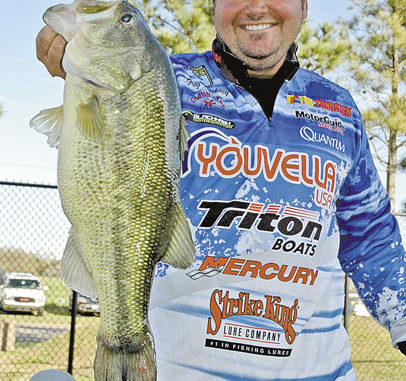
Most of my attention for the first of this month will be focused on fishing and winning the 2010 Bassmaster Classic on Lay Lake in Birmingham, Ala.
If I win, I doubt I’ll be fishing much in February. However, if I don’t win, I know February is one of the best months to fish anywhere in Louisiana and catch a wall-hanger, particularly at Lake Chicot near Ville Platte and Caney Lake in north-central Louisiana.
Both these lakes should produce many 8- to a 10-pound bass this month, even though they fish quite differently.
Lake Chicot
The February bass on Chicot will be somewhat further along in the spawn than the bass on Caney Lake. More than likely, the Chicot bass will be holding on cypress trees close to bedding areas.
If the weather’s extremely cold, I’ll fish a lipless crankbait, like a 1/2-ounce chrome or orange Red Eye Shad, around the trees or a Hack Attack Jig or Premier Pro-Model spinnerbait.
Caney Lake
This month on clear Caney Lake, the bass will be holding more on structure. On a warm afternoon, you can catch bass on the lily-pad flats.
Once again, the lipless crankbait in red-craw/chartreuse or orange craw is hard to beat for catching big bass during the month of February, especially on those warming days. Just before the bass spawn, the lipless crankbait catches more 8- to 10-pound bass than any other type of lure.
I’m often asked how I keep the bass from throwing a lipless crankbait or any crankbait. Having the bass throw a crankbait once was a problem for me, and occasionally I still have bass throw crankbaits. However, I use a parabolic rod and put a lot of pressure on the fish when I’m bringing it to the boat. I try to pull the bass back down into the water when I see it coming up.
The weight of the lure flopping in the bass’s mouth is what causes the lure to flip out. So, when I see my line coming up and know the bass is trying to get to the surface to throw the lure, I start reeling and pulling hard sideways. I’ll even stick my rod down into the water and crank hard to keep the bass down and the slack out of the line. The bass can’t throw the lure unless it gets slack in the line.
Also, you want a soft-tipped rod so you won’t pull the hooks out of the bass’s mouth when you’re putting pressure on it. There’s a fine line between putting enough pressure on the bass to keep it from jumping and not putting so much pressure on the line that you pull the lure out of the fish’s mouth.
My rod of choice is a 7-foot Quantum Energy PT rod. Although this rod is flat and looks big and heavy, it’s lightweight.
The line to use
In cold weather like February, I prefer 30- to 50-pound-test Cajun Braid Line because the bass’s mouth is hard in cold water. A bass’s mouth in warm weather feels soft. A hard mouth will make you have a more difficult time getting the hooks into the bass’s mouth, which is why I like stronger line to get that hook set.
This way, if I get a bite at the end of a 40-yard cast, even though I’ve got a soft tip on my rod with no-stretch braided line, I still can get a really solid hook in the bass’s mouth.
As the months become warmer, I’ll change from braided line to fluorocarbon line since I want more stretch in the line during warmer months. However, as long as the water temperature is 65 degrees or less, I’ll be fishing braided line on lipless crankbaits.
I like nasty days
Regardless of whether you’ll be fishing Lake Chicot or Caney Lake, fish on the nastiest day of the month. In February, folks start getting cabin fever and thinking about fishing again. Those bad and nasty days will keep those potential fishermen at home near their fires, and you’ll probably have these lakes to yourself.
I won’t be fishing for a lot of bites, but I’ll be fishing these two lakes this month to catch really big bass. Any bass over 7 pounds really gets me excited.
Caney Lake probably will give you your best chance to catch a 10-pound-plus bass. I fished Caney during its heyday, and remember putting my boat in at Brown’s Landing with its aquarium holding three bass weighing between 13 and 15 pounds each that had been caught from Caney.
The lake once had a lot of grass, but it was killed, and the bass went through a down cycle. However, Caney still consistently produces 8- to 10-pound February bass.
If I want to see plenty of cover and have a chance of catching a 7-pound-plus bass, Lake Chicot will be my choice. Lake Chicot also has nice cabins, campgrounds and RV spots, and it’s definitely one of my favorite lakes.
Whichever lake you choose, February is the month to try to catch a big Louisiana bass.


